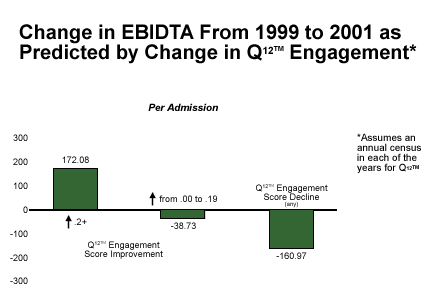The debate over healthcare reform in the U.S. is often framed as a matter of conflicting priorities: improving the quality of care versus ensuring the financial well-being of healthcare organizations. But many healthcare professionals may not realize that by simply targeting the right workplace factors for improvement, both goals may be met simultaneously.
As in all industries, employee attitudes are among the most critical of those factors. But even among hospitals that do seek out employees' opinions, many don't ask the right questions or do little to implement change based on the results. Most employee surveys make things worse, not better, according ║┌┴¤═°'s 1993 study of human resources and organizational development personnel in Fortune 500 companies. Eighty percent (80%) of those companies reported they did employee surveys, and a staggering 60% actually reported being "worse off" after those surveys.
The key question is not, "How satisfied are my employees?" It is, "How strong is our culture?" The answer requires a focused approach based on items of proven impact. To improve, healthcare organizations must select a process that is implemented at the local, or "workgroup" level. This process must be seen as ongoing and not just a single event. And in today's cost-driven environment, simply improving employee satisfaction scores may not be enough to make your organization healthy. The true objective hasn't been reached until the organization can document the impact of those improvements on its bottom line.
║┌┴¤═° has tested more than 1 million questions to identify the 12 key indicators of employee engagement. Using hospitals in its database, ║┌┴¤═° tracked the impact of change in Q12 engagement scores with Earnings Before Interest, Depreciation and Taxes (EBIDTA) from 1999 to 2001. Between those years, EBIDTA increased an average of $172.08 per admission for those who increased their Q12 engagement scores by 4% or more. If Q12 engagement increased less than 4%, EBIDTA declined an average of $38.73. If Q12 engagement declined overall, EBIDTA declined an average of $160.97 per admission.

Employee engagement is a crucial driver of success for healthcare organizations. Expanding on that, focusing on the appropriate dimensions and committing to a workgroup-based improvement process, engaged employees are also a key to bottom-line improvement. Based on the findings, if the average hospital has 200 beds and 12,500 admissions per year and improves its employee engagement 4% or more, it can expect an additional $2,151,000 on its bottom line. But more importantly, engaged employees deliver better customer care. That's a healthy development for everyone.